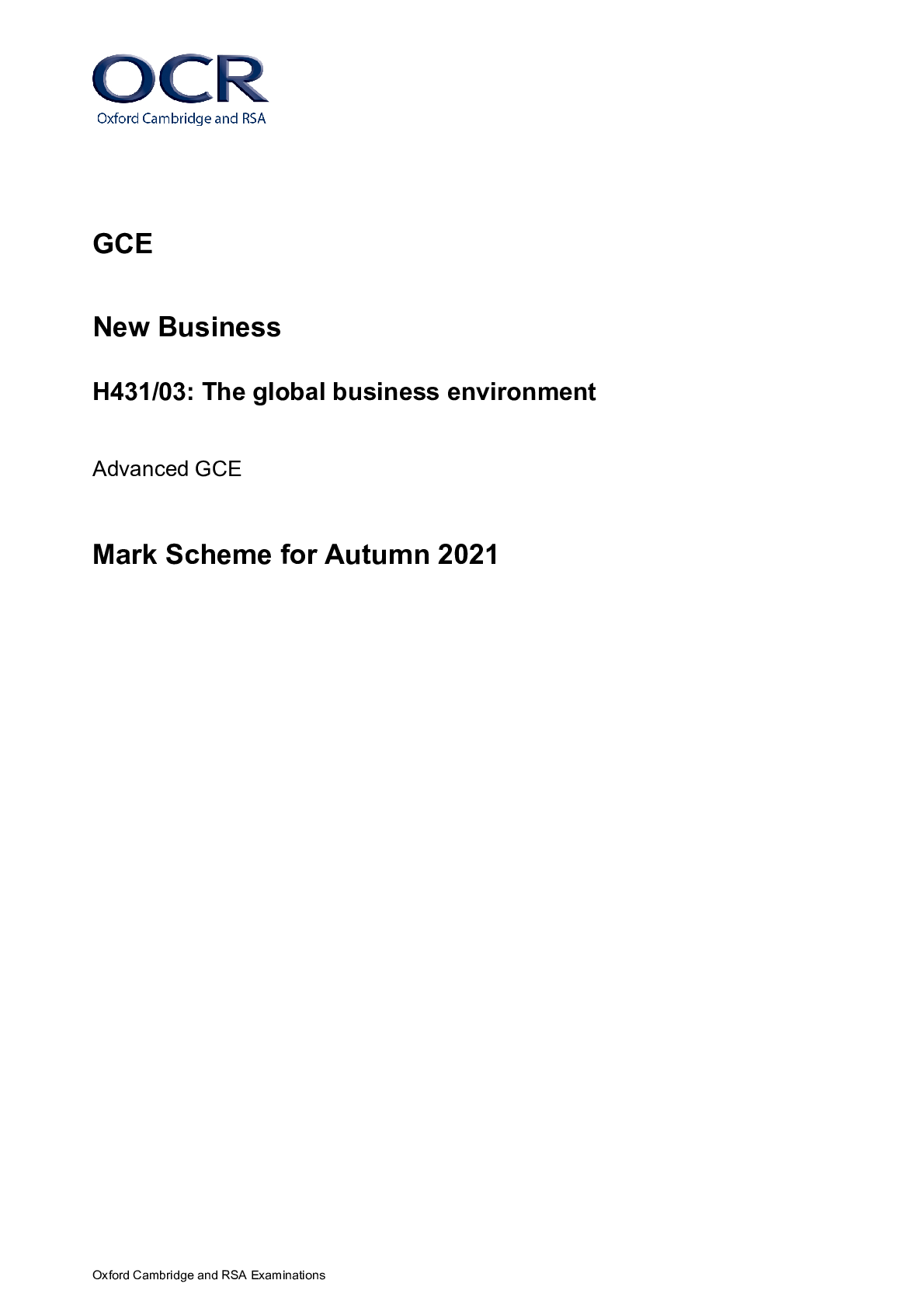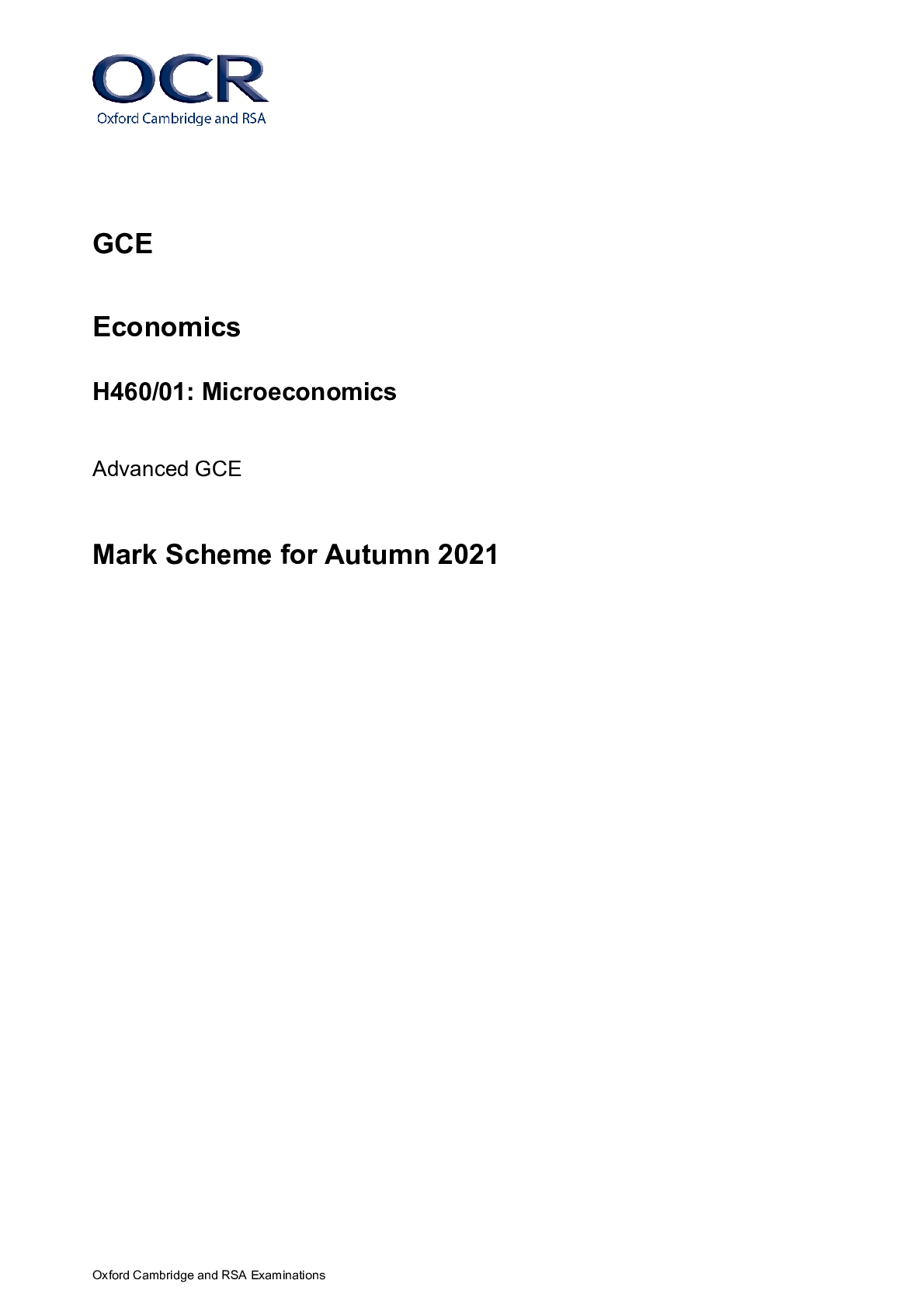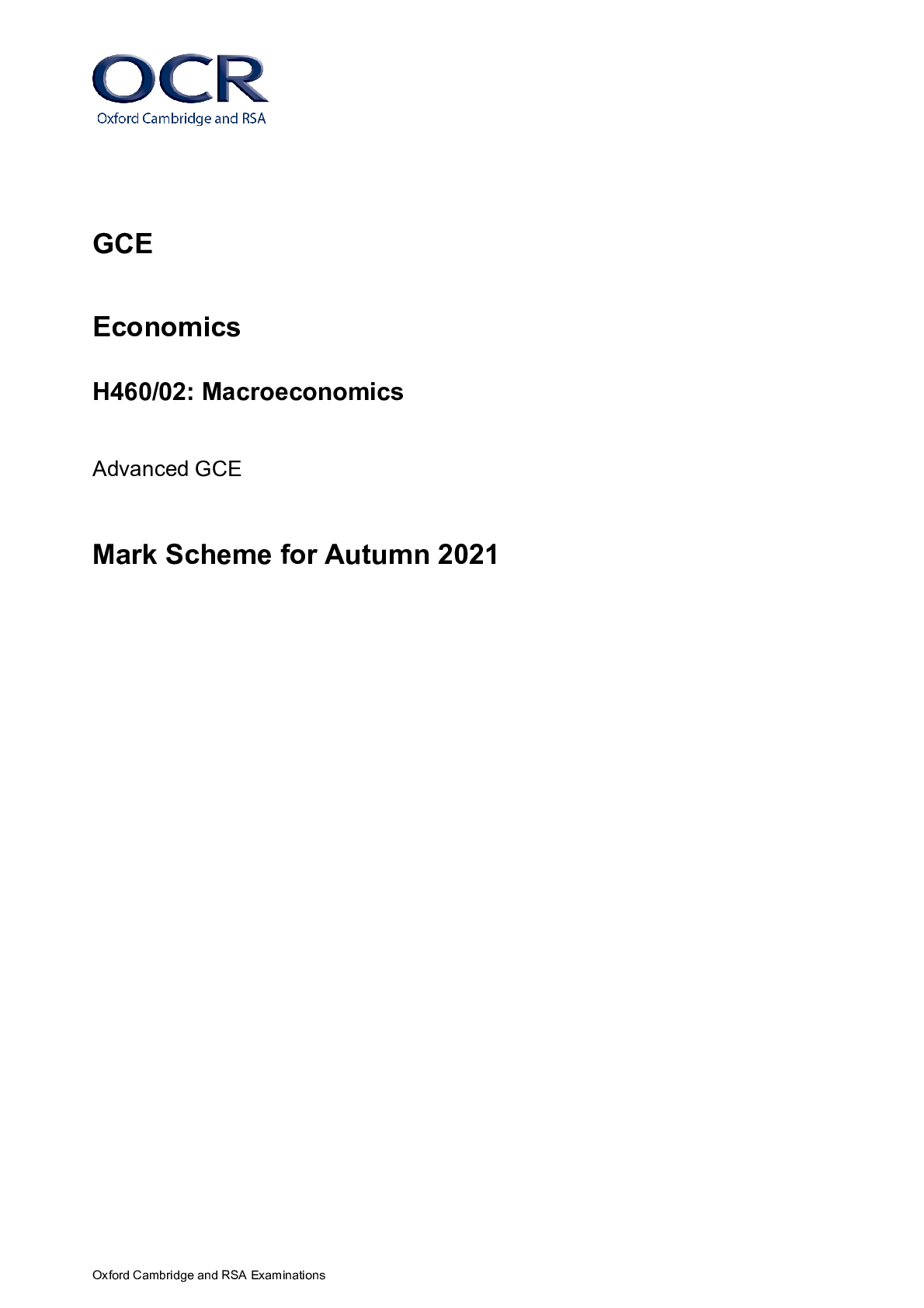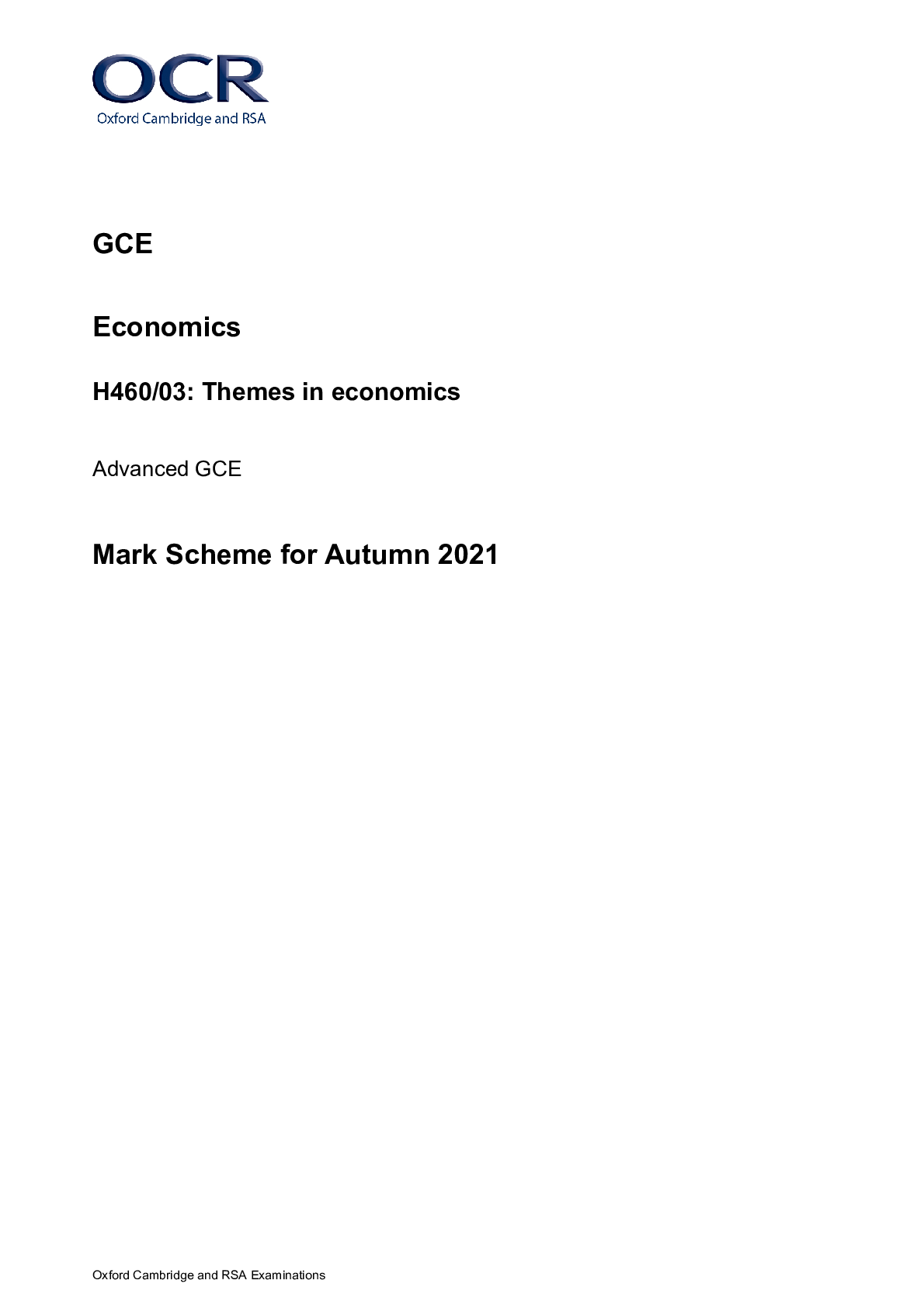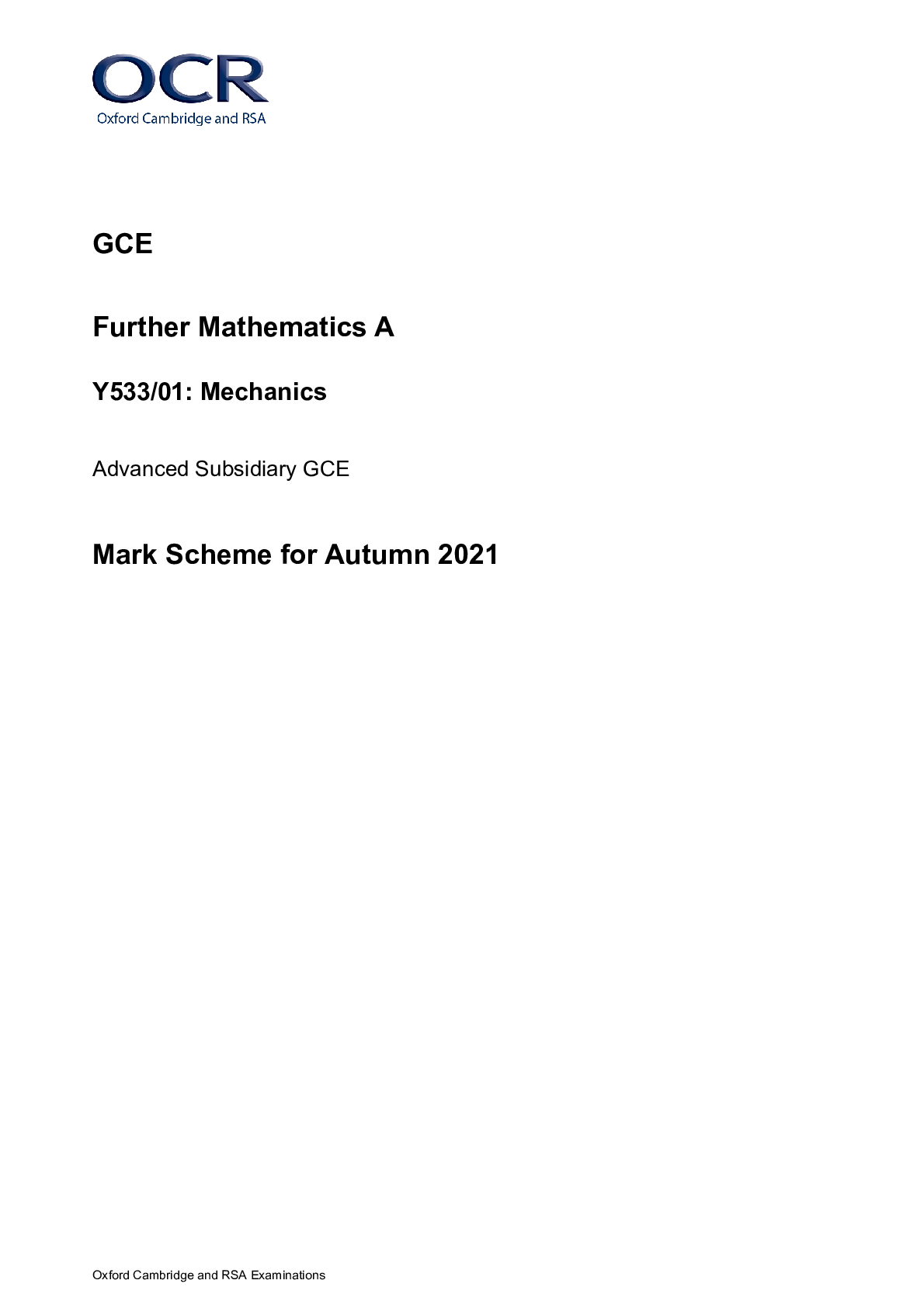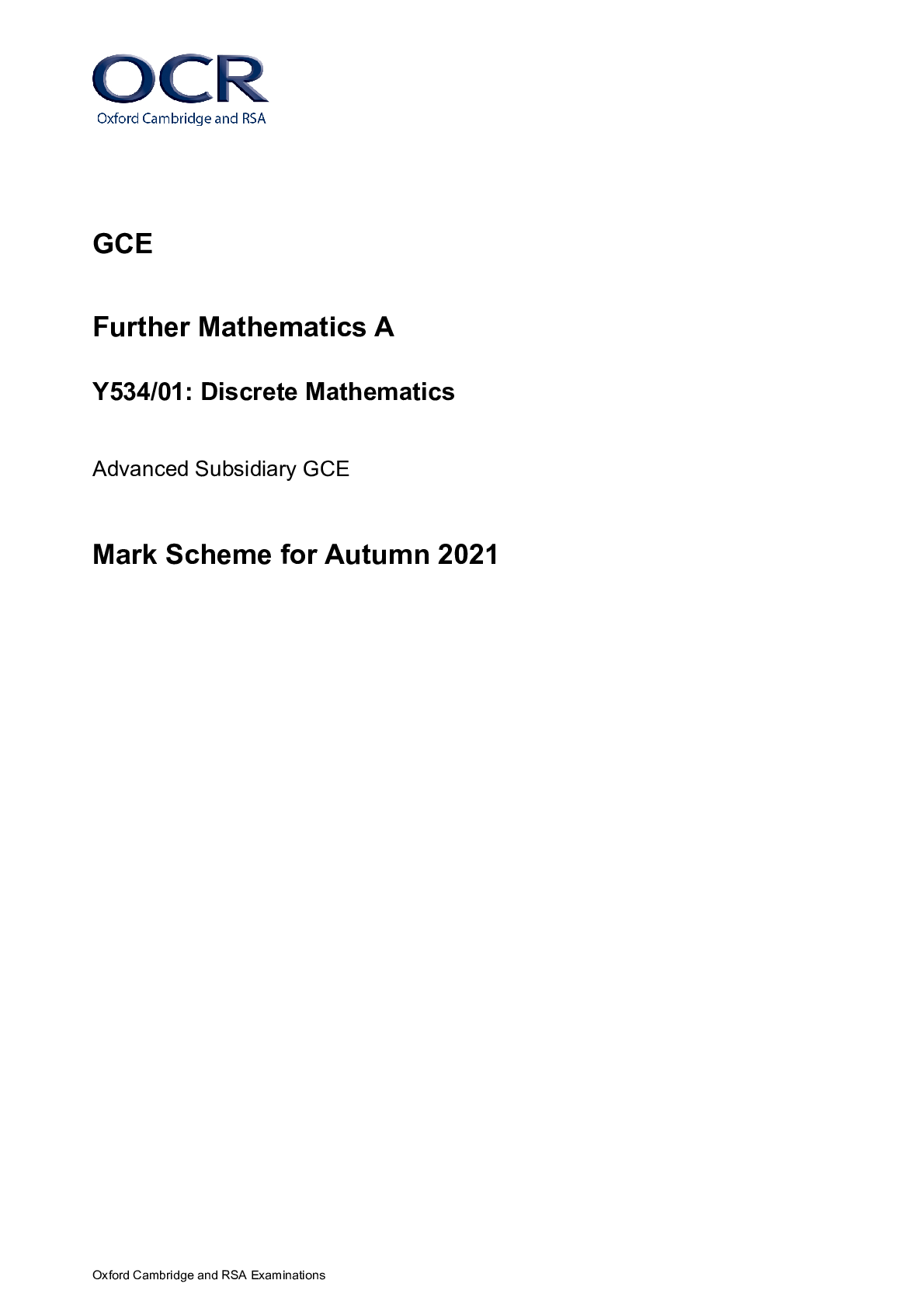Sociology > MARK SCHEME > GCE Sociology H580/03: Debates in contemporary society Advanced GCE Mark Scheme for Autumn 2021 (All)
GCE Sociology H580/03: Debates in contemporary society Advanced GCE Mark Scheme for Autumn 2021
Document Content and Description Below
GCE Sociology H580/03: Debates in contemporary society Advanced GCE Mark Scheme for Autumn 2021 Oxford Cambridge and RSA Examinations GCE Sociology H580/03: Debates in contemporary society ... Advanced GCE Mark Scheme for Autumn 2021Oxford Cambridge and RSA Examinations OCR (Oxford Cambridge and RSA) is a leading UK awarding body, providing a wide range of qualifications to meet the needs of candidates of all ages and abilities. OCR qualifications include AS/A Levels, Diplomas, GCSEs, Cambridge Nationals, Cambridge Technicals, Functional Skills, Key Skills, Entry Level qualifications, NVQs and vocational qualifications in areas such as IT, business, languages, teaching/training, administration and secretarial skills. It is also responsible for developing new specifications to meet national requirements and the needs of students and teachers. OCR is a not-for-profit organisation; any surplus made is invested back into the establishment to help towards the development of qualifications and support, which keep pace with the changing needs of today’s society. This mark scheme is published as an aid to teachers and students, to indicate the requirements of the examination. It shows the basis on which marks were awarded by examiners. It does not indicate the details of the discussions which took place at an examiners’ meeting before marking commenced. All examiners are instructed that alternative correct answers and unexpected approaches in candidates’ scripts must be given marks that fairly reflect the relevant knowledge and skills demonstrated. Mark schemes should be read in conjunction with the published question papers and the report on the examination. © OCR 2021H580/03 Mark Scheme October 2021 Annotations Annotation Meaning Knowledge and Understanding: for example, studies or theories. Developed Point: fully explained in a relevant way Concept Underdeveloped: Partially explained, but requiring more depth Example Application Evaluation Unsubstantiated/ undeveloped/ implicit / accurate without explanation/ support Unclear/confused/inaccurate Repetition Irrelevant - not focused on question set Juxtaposition of theories without direct evaluationH580/03 Mark Scheme October 2021 12. Subject Specific Marking Instructions INTRODUCTION Your first task as an Examiner is to become thoroughly familiar with the material on which the examination depends. This material includes: • the specification, especially the assessment objectives • the question paper and its rubrics • the texts which candidates have studied • the mark scheme. You should ensure that you have copies of these materials. You should ensure also that you are familiar with the administrative procedures related to the marking process. These are set out in the OCR booklet Instructions for Examiners. If you are examining for the first time, please read carefully Appendix 5 Introduction to Script Marking: Notes for New Examiners. Please ask for help or guidance whenever you need it. Your first point of contact is your Team Leader. USING THE MARK SCHEME Please study this Mark Scheme carefully. The Mark Scheme is an integral part of the process that begins with the setting of the question paper and ends with the awarding of grades. Question papers and Mark Schemes are developed in association with each other so that issues of differentiation and positive achievement can be addressed from the very start. This Mark Scheme is a working document; it is not exhaustive; it does not provide ‘correct’ answers. The Mark Scheme can only provide ‘best guesses’ about how the question will work out, and it is subject to revision after we have looked at a wide range of scripts.H580/03 Mark Scheme October 2021 The Examiners’ Standardisation Meeting will ensure that the Mark Scheme covers the range of candidates’ responses to the questions, and that all Examiners understand and apply the Mark Scheme in the same way. The Mark Scheme will be discussed and amended at the meeting, and administrative procedures will be confirmed. Co-ordination scripts will be issued at the meeting to exemplify aspects of candidates’ responses and achievements; the coordination scripts then become part of this Mark Scheme. Before the Standardisation Meeting, you should read and mark in pencil a number of scripts, in order to gain an impression of the range of responses and achievement that may be expected. Please read carefully all the scripts in your allocation and make every effort to look positively for achievement throughout the ability range. Always be prepared to use the full range of marks.H580/03 Mark Scheme October 2021 USING THE MARK SCHEME Please study this Mark Scheme carefully. The Mark Scheme is an integral part of the process that begins with the setting of the question paper and ends with the awarding of grades. Question papers and Mark Schemes are developed in association with each other so that issues of differentiation and positive achievement can be addressed from the very start. This Mark Scheme is a working document; it is not exhaustive; it does not provide ‘correct’ answers. The Mark Scheme can only provide ‘best guesses’ about how the question will work out, and it is subject to revision after we have looked at a wide range of scripts. The Examiners’ Standardisation Meeting will ensure that the Mark Scheme covers the range of candidates’ responses to the questions, and that all Examiners understand and apply the Mark Scheme in the same way. The Mark Scheme will be discussed and amended at the meeting, and administrative procedures will be confirmed. Co-ordination scripts will be issued at the meeting to exemplify aspects of candidates’ responses and achievements; the coordination scripts then become part of this Mark Scheme. Before the Standardisation Meeting, you should read and mark in pencil a number of scripts, in order to gain an impression of the range of responses and achievement that may be expected. Please read carefully all the scripts in your allocation and make every effort to look positively for achievement throughout the ability range. Always be prepared to use the full range of marks.H580/03 Mark Scheme October 2021 Question Answer Marks Guidance 1 * With reference to the Source(s) and your wider sociological knowledge explain the impact of developments in digital communication on social capital in employment. AO1: Knowledge and understanding Level 4: 5 marks The candidate demonstrates an excellent knowledge and understanding of a range of sociological material; the material is generally accurate and detailed. There is a well-developed line of reasoning which is clear and logically structured. The material presented is relevant and supported by evidence. There will typically be two developed points of knowledge. Level 3: 3–4 marks The candidate demonstrates a good knowledge and understanding of either a range of sociological material or some material in detail. The material is generally accurate but underdeveloped. There is a line of reasoning presented with some structure. The material presented is mostly relevant and supported by some evidence. There will typically be one developed point of knowledge, or 2 less well-developed points. Level 2: 2 marks The candidate demonstrates a basic knowledge and understanding of some sociological material. The response lacks range and detail. The response may lack clarity at times and contain some inaccuracies. The response may be partial and undeveloped. The material has some relevance and is supported by limited evidence. There will typically be one underdeveloped point of knowledge, or two undeveloped points. Level 1: 1 mark The candidate demonstrates a limited knowledge and understanding of sociological material. Very little relevant 9 AO1: Knowledge and understanding This might include consideration of: • Social capital enables a person to exert power on the group or individual who mobilises resources, social capital resides in the individual as the result of his or her investment; Bourdieu • Previously people needed to rely on word of mouth, newspapers, job centres etc to discover job opportunities, today they can gain insight through work based social networking sites at the touch of a button. (As in Source A) • Access to work-based social networking sites. (As in Source A) • Virtual networks such as LinkedIn – access to employment opportunities, Monster.co.uk, Indeed.co.uk • Increased access to opportunities across the world (As in Source A) • Developments in social media enable C.V.s to be easily shared with people at a global level • Individuals can get support through new forms of digital communication, such as CV and interviewing tips, regardless of their geographical location. • Global networking provides more employability and hierarchical status opportunities, through relationships and/or connections with people and groups across the world. • Social mobility opportunities. • Work based global network provide opportunities to increase social capital (As in Source A) • Social media sites can be used as a marketing tool to signpost a product or a business. • Discussions arising from social networking experiences can affect decisions people make in life and in business; Cohn, 2012 • Opportunities to launch businesses through social network sites. This has helped break down barriers to employment, for example for people with a disability orH580/03 Mark Scheme October 2021 sociological material is presented; the response contains considerable inaccuracy and lacks clarity. The material is basic and communicated in an unstructured way. There will typically be one undeveloped point, or a vague representation. 0 marks No relevant knowledge or understanding. AO2: Application Level 4: 4 marks The candidate demonstrates an excellent ability to apply relevant source material. The candidate has explicitly and frequently applied material from at least one of the sources in a developed way. There will typically be two developed references to the source material. Level 3: 3 marks The candidate demonstrates a good ability to apply source material. The candidate has occasionally applied material from at least one of the sources in a developed way, or frequently applied the source(s) in an underdeveloped way. There will typically be one developed or two underdeveloped references to the source material. Level 2: 2 marks The candidate demonstrates a basic ability to apply source material. The candidate has occasionally made use of material from the source(s) in an underdeveloped way. There will typically be one underdeveloped or two undeveloped/ recycled/ implicit references to the source material. Level 1: 1 mark The candidate shows a limited ability to apply source caring responsibilities. (As in Source A, World Development Report: 2016) • Opportunities to access opportunities outside traditional old boys’ network; Castells • Access to jobs offered on-line, Skype interviewing for jobs abroad. • Ease of access to information about companies in preparation for job applications/interviews. • Opportunities to access market information before launch of a new business. • Cyborg manifesto transcend gender thus gender inequality could be less of an issue for employment; Haraway • Negative employment opportunities; people trafficking; Hughes • Other reasonable response. AO2: Application In this question AO2 is awarded for use of source/s.H580/03 Mark Scheme October 2021 material. The candidate has implicitly referred to issues raised in the source(s) or recycled source materials in an undeveloped way. There will typically be one undeveloped/ recycled/ implicit reference to the source material. 0 marks No relevant sociological application. 2 With reference to the Source(s) and your wider sociological knowledge, evaluate the view that social media has a positive role in people’s social lives AO1: Knowledge and understanding Level 4: 4 marks The candidate demonstrates an excellent knowledge and understanding of a range of sociological material; the material is generally accurate and detailed. There is a well-developed line of reasoning which is clear and logically structured. The material presented is relevant and supported by evidence. There will typically be two developed points supporting the view in the question. Level 3: 3 marks The candidate demonstrates a good knowledge and understanding of either a range of sociological material or some material in detail. The material is generally accurate but underdeveloped. There is a line of reasoning presented with some structure. The material presented is mostly relevant and supported by some evidence. There will typically be one developed point or two underdeveloped points supporting the view in the question. Level 2: 2 marks The candidate demonstrates a basic knowledge and understanding of some sociological material. The response lacks range and detail. The response may lack clarity at times and contain some inaccuracies. The response may be partial and 10 AO1: Knowledge and understanding Contemporary examples of social media should be rewarded the same AO1 marks as references to studies. Arguments that the development of social media has a positive role in people’s lives, including: • Developments in digital forms of communication have helped increase access to people across the world. This is particularly evident in social media networking. (As in Source A). • Until recently most people interacted face-to-face or through landline telephones- this form of interaction was limited, global relationships difficult to develop and maintain (As in Source B) • Facebook began as a way of enabling Harvard University students to communicate and connect with each other, has broader appeal today - popular across the world • Social media networking changed nature of relationships such as friendship groups and helped families maintain contact across the world (As in source B) • More than half the UK population over age 18 use social media networks such as Facebook and Instagram to connect and communicate with others (As in Source B) • Human relationships are at the heart of social media's success; Cohn 2012 • Social media, e.g. WhatsApp, allows relationships to flourish due to the ease of interactions; Cohn, 2012H580/03 Mark Scheme October 2021 undeveloped. The material has some relevance and is supported by limited evidence. There will typically be one underdeveloped or two undeveloped points supporting the view in the question. Level 1: 1 mark The candidate demonstrates a limited knowledge and understanding of sociological material. Very little relevant sociological material is presented; the response contains considerable inaccuracy and lacks clarity. The material is basic and communicated in an unstructured way. There will typically be one undeveloped point supporting the view in the question, or a vague representation. 0 marks No relevant knowledge or understanding. AO2: Application Level 2: 2 marks The candidate demonstrates an excellent ability to apply relevant source material. The candidate has explicitly interpreted and applied material from at least one of the sources. There will typically be at least one partially developed reference to source material. Level 1: 1 mark The candidate shows a limited ability to apply source material. The candidate has implicitly referred to issues raised in the source(s) or recycled source materials in an undeveloped way. There will typically be at least one undeveloped reference to source material. 0 marks No relevant sociological application. AO3: Analysis and evaluation Level 4: 4 marks The candidate demonstrates an excellent ability to analyse and evaluate sociological material. There is a range of developed evaluation points. There may be a critical and reasoned conclusion. • Isolation is a serious cause of concern amongst elderly - by using digital forms of communication, they can stay in contact with friends and family – the NHS Live well website • Provides a voice to the muted; Nakamara • Campaigns to reach out and bring support to victims e.g. Everyday Sexism • Psychological benefits against depression etc for those who do not have active social lives; Shaw and Gant • Miller Tales from Facebook; Miller • Virtual communities create online and then offline relationships/social lives; Carter • Improving social lives of elderly through websites such as Finerday; Berry • Other reasonable response. AO2: Application In this question AO2 is awarded for use of source/s AO3: Analysis and evaluation Arguments against the view that social media has a positive role in people’s social lives. • Digital communication provides a new form of surveillance. Private companies can gather information on people’s use of social media, their consumer habits, without their knowledge and consent, for example Facebook using cookies to send personalised advertising (as in Source B) • Digital communication is a new form of social control (as in Source B, also Cornford and Robbins). • Growth of cyberbullying, e.g. Ask FM, Hannah Smith suicide • Issue with fake identities in chat rooms. • Some groups are unable to access new forms of digital communication and social media. Issues of cost related marginalisation in Cuba. • Data from individuals who use social media can be used against their will. In 2018 Facebook maintained up to 87H580/03 Mark Scheme October 2021 There will typically be two developed points challenging the view in the question. Level 3: 3 marks The candidate demonstrates a good ability to analyse and evaluate sociological material. There is some analysis and evaluation, but it will be underdeveloped or narrow. The candidate may reach an explicit but brief conclusion. There will typically be one developed point or two underdeveloped points challenging the view in the question. Level 2: 2 marks The candidate demonstrates a basic ability to analyse and evaluate sociological material. Evaluation points are likely to be undeveloped, with little supporting evidence. If present, the conclusion is likely to be summative. There will typically be one underdeveloped or two undeveloped points challenging the view in the question. Level 1: 1 mark The candidate demonstrates a limited ability to analyse and evaluate sociological material. Only brief and/or implicit evaluation is present. There is unlikely to be a conclusion. There will typically be one undeveloped point challenging the view in the question, or a vague representation. 0 marks No relevant sociological evaluation or analysis. million users' data was improperly shared with Cambridge Analytica, also Cornford and Robins • Individuals leave a digital footprint which is difficult to erase and can have negative implications in later life in terms of personal lives and employment; e.g. Paris Brown youth police crime commissioner had to step down due to previous politically incorrect tweets. • The relationships developed on social media may be more superficial. • Social media may be used illegitimately, for example grooming young people. • The Twitter effect: may lead to conflict in real life relationships or lack of development; Clayton, Turkle • Blurring of on-line and offline identities; postmodern view • Families may spend less time having face-to-face communication affecting relationships • Increased time on social media: less time exploring the natural world. Tales from Facebook; Miller • Our developing relationships with digital assistants such as Siri and Alexa are programmed to mimic human interactions – can become toxic. • Other reasonable response. 3 Evaluate the sociological view that the impact of advances in digital forms of communication on young people has been negative. AO1: Knowledge and understanding Level 4: 4 marks The candidate demonstrates an excellent knowledge and understanding of a range of sociological material; the material is generally accurate and detailed. There is a well-developed line of reasoning which is clear and logically structured. The material presented is supported by evidence. 16 AO1: Knowledge and understanding Candidates may consider relevant material and arguments supporting the view that the impact of advances in digital forms of communication on young people has been negative including: • Globally children at increasing risk of exploitation through digital forms of communication: CEOP • Technology enabled development of modern-day slavery - young people at risk; the Centre for Social Justice 2013H580/03 Mark Scheme October 2021 There will typically be two developed points supporting the view in the question. Level 3: 3 marks The candidate demonstrates a good knowledge and understanding of either a range of sociological material or some material in detail. The material is generally accurate but underdeveloped. There is a line of reasoning presented with some structure. The material presented is supported by some evidence. There will typically be one developed point or two underdeveloped points supporting the view in the question. Level 2: 2 marks The candidate demonstrates a basic knowledge and understanding of some sociological material. The response lacks range and detail. The response may lack clarity at times and contain some inaccuracies. The response may be partial and undeveloped. The material presented is supported by limited evidence. There will typically be one underdeveloped or two undeveloped points supporting the view in the question. Level 1: 1 mark The candidate demonstrates a limited knowledge and understanding of sociological material. The material is basic and communicated in an unstructured way. Very little relevant sociological material is presented; the response contains considerable inaccuracy and lacks clarity. There will typically be one undeveloped point supporting the view in the question, or a vague representation. 0 marks No relevant knowledge or understanding. AO2: Application Level 4: 4 marks • When people assume children have access to smartphones or the internet they may be disadvantaged in education and peer interaction in all countries; Berry • The internet has assisted in the illegal trafficking of children; Arlaccki • Digital forms of communication have enabled the reproduction of children’s exploitation across the world; Hughes • The internet has enabled the exploitation of children online, - grooming, child pornography; CEOP • Compared to older generations ‘the millennium generation is losing its voice’; Ofcom 2014 • Young more at risk than older generations from cyberbullying, sexual abuse on-line, idealised gender expectations; Garside, Barnardo’s • Social media can lead to family members being, ‘alone together’; Turkle • Internet may expose young people to inappropriate adult content e.g. sex, violence e.g. boys and gaming. Childhood is disappearing; Postman • Technology in bedrooms leads to ‘toxic childhood’; Palmer • Compared with previous generations young people today face the issue of social media footprints – hard to remove mistakes; Case, Ellison. • Other reasonable response. AO2: Application The selected knowledge should be directly specific to the question - view that the impact of advances in digital forms of communication on young people has been negativeH580/03 Mark Scheme October 2021 The candidate demonstrates an excellent ability to apply relevant sociological material. The material relevant and is consistently and frequently related to the question Level 3: 3 marks The candidate demonstrates a good ability to apply sociological material. The material is generally relevant but is explicitly related to the question only occasionally. Level 2: 2 marks The candidate demonstrates a basic ability to apply sociological material. The material is related to the question mainly implicitly and lacks focus on the question. The response may be generalised. Level 1: 1 mark The candidate demonstrates a limited ability to apply sociological material. The material is tangential to the question and of marginal relevance. 0 marks No relevant sociological application. AO3: Analysis and evaluation Level 4: 7–8 marks The candidate demonstrates an excellent ability to analyse and evaluate sociological material. There are a range of evaluation points which are well developed. The candidate may reach a critical and reasoned conclusion. There will typically be three developed points or two developed points and one underdeveloped point challenging the view in the question. Level 3: 5–6 marks The candidate demonstrates a good ability to analyse and evaluate sociological material. There are some evaluation points, but these may be underdeveloped or narrow. The candidate may reach a critical but brief conclusion. AO3: Analysis and evaluation Arguments challenging the view that the impact of advances in digital forms of communication on young people has been negative: • Through social media, young people can send messages, share photographs, videos across the world at the press of a button; Boyle, Boellstorff • Children potentially better informed than previous generations, a large proportion of the young population have access to the internet. • More potential to increase social capital; Bourdieu, Boyle • Children today can learn skills relevant to the 21st century, such as employability skills on-line • Access to young people across the world may help with confidence in expressing identity; Nakamara, Carter • Increased ability to develop personal identities; Case • Postmodern view - more choice in writing their lives and choosing identity Bjorkland. • Children more informed about world events, political and social and are potentially more engaged than previous generations. • Improves access to shared interests and experiences e.g. social movements and on-line campaigns, the Girl Guides organisation introduced a Campaigning and Activism badge; Cochrane • Age can be transcended and thus reduce age discrimination; Haraway • The young are creating a digital divide where it is the elderly who are being left out. • Other reasonable response.H580/03 Mark Scheme October 2021 There will typically be two developed points or three underdeveloped points challenging the view in the question. Level 2: 3–4 marks The candidate demonstrates a basic ability to analyse and evaluate. Evaluation points may be undeveloped or lacking in range. The evaluation may lack clarity and contain some inaccuracies/ confusion. If present, the conclusion is likely to be summative. There will typically be one developed or two underdeveloped points challenging the view in the question. A range of undeveloped points may also be seen at this level. Level 1: 1–2 marks The candidate demonstrates a limited ability to analyse and evaluate. Only brief and/or implicit evaluation is present. There is unlikely to be a conclusion. There will typically be one or two undeveloped or vague points which could potentially challenge the view in the question. 0 marks: No relevant sociological evaluation or analysis. 4 * In what ways are victim surveys a useful measurement of crime? PLEASE REFER TO APPENDIX 1 10 AO1: Knowledge and understanding Candidates may refer to: • Alternative way of measuring crime – surveying people about which crimes they have been victims of in a given period. • Insight into ‘dark figure of crime’ - crimes not reported to the police; balances information provided from police recorded crime statistics; Hough and Mayhew • CSEW largest victim study carried out on behalf of Home Office; face-to-face structured interviews; representative sample of adults and children, therefore can generalise data. • CSEW successful in developing measures to estimate extent of domestic violence • Unlike police statistics, victim surveys include questions on people’s attitudes to crime related topics e.g. antisocial behaviour.H580/03 Mark Scheme October 2021 • Confidentiality in the surveys is promised - people can talk without repercussions, therefore some more likely to admit to being a victim of crime than report incident to police. • Islington Crime Surveys used unstructured interviews to collect qualitative data on victims’ experiences of crime. Provided insights used in the development of Left Realist views on causes and possible solutions to crime; Lea and Young • Islington and Merseyside Crime Surveys focused on the impact of crime on individual’s lives especially vulnerable groups, gaining more valid insights; Kinsey, Jones et al • Islington Survey found higher rate of female victimisation regarding sexual and domestic offences than police statistics; Young, • Victim research informed radical feminist views on patriarchy; Dobash and Dobash • Left Realist and Feminists use data from victim surveys which raised awareness of the impact of fear of crime on people’s lives; Young • The insights gained from victim surveys can be used to enhance understanding of patterns of crime published in police recorded statistics. AO2: Application The selected knowledge should be directly specific to the question: the ways victim surveys are a useful measurement of crime. 5 * Assess the view that the main influence on female patterns of crime is traditional gender socialisation. PLEASE REFER TO APPENDIX 2 20 AO1: Knowledge and understanding Candidates may consider feminist and functionalist views on traditional gender socialisation and patterns of crime including: • Some feminists focus on why all females do not commit crime – differential gender socialisation- girls more closely supervised in our patriarchal society less opportunities for crime and deviance; SmartH580/03 Mark Scheme October 2021 • Females socialised to view crime as role-distorting; going against expected role of nurturer and carer. Women more to lose if deviant, liberty and reputation, ‘double deviance’; Heidensohn • Women and girls during formative years of socialisation experience control in the home and in public, less opportunity to commit crime; Heidensohn, McRobbie • Functionalist view – sex role theory, boys and girls socialised differently; Sutherland • Gender role models lead to different behaviour; Parsons • Female offenders who conform to stereotypical views of femininity receive less harsh treatment’, but those who do not comply with stereotypical views can receive harsher treatment result of traditional socialisation; Heidensohn, the Journal of Criminal Justice,2015 • Women who carry out crimes that are violent or against children receive very harsh punishments e.g. Myra Hindley; Maxine Carr • The criminal justice system’s response toward women enforces stereotypical female sex roles that perpetuate patriarchy; Birch, Chesney-Lind, Lloyd • When a woman is a mother, the court will take this into account; Hedderman and Gunby, Ministry of Justice 2014 • Other reasonable response AO2: Application The selected knowledge should be directly specific to the question - view that the main influence on female patterns of crime is traditional gender socialisation. AO3: Analysis and evaluation Candidates are expected to discuss weaknesses of the view that the main influence on female patterns of crime is gender socialisation and may consider theories such as such as: • Feminist liberation theoryH580/03 Mark Scheme October 2021 • Biological argument • Marxist view • Postmodern view Candidates will discuss weaknesses of view that the main influence on female patterns of crime is traditional gender socialisation including: • Influence of Feminism – liberation thesis and rise of the new female criminal; Adler • Increase and more acceptance for the ‘ladette’; Jackson; Denscombe - unfortunately not supported by statistics • ‘Class deal’ and ‘gender deal’ - cost benefit analysis can be applied to women who do commit crime, they have less to lose, e.g. brought up in care system, level of education; Carlen • Women are compelled by their physiology to commit certain crimes; Pollak • Women get away with offending – there is a biological link between menstruation and women’s concealment of crime; Pollak • Women manipulate men to commit crime for them; Pollak • Some research supports biological argument - PMS accepted as reason for violent crime in a significant number of cases; Moir and Jessel • Most women are genetically less inclined towards criminality; Lombroso • Women possess personality traits making them less inclined than men to engage in criminality; Thomas • Self-report studies reveal a dark figure of female crime; Graham and Bowling, Youth Lifestyle Survey • Chivalry thesis: patterns of crime related to lenience by police/ courts rather than female behaviour/ socialisation.H580/03 Mark Scheme October 2021 • Link between social class and prevalence and treatment of female offenders. Middle class white women receive less harsh treatment than women of other social classes and ethnicities; Klein, James and Thornton • Women are not treated more leniently than men for similar offences; Farrington and Morris • Other reasonable response. 6 * Evaluate the view that there is racism and discrimination within the criminal justice system. PLEASE REFER TO APPENDIX 3 40 AO1: Knowledge and understanding The debate revolves around those who highlight racism within the criminal justice system, those who argue certain ethnic groups are actually more criminal and those who maintain the views are not mutually exclusive. Candidates may draw upon different theoretical approaches such as: • Interactionism • Marxism • Left wing views Candidates are expected to consider sociologists who maintain there is racism and discrimination in the criminal justice system: • Interactionist view and negative labelling of black males, ‘colour-coding’; Anderson • The Scarman Report (1982), social and economic disadvantages faced by members of minority ethnic groups could create disposition towards violent protest, but also discovered racist police officers, ‘bad apples’, recommended Racial Awareness Training Programmes • Institutional racism within the social processes and practises of the criminal justice system, courts, police etc • McPherson Report (1999) discovered institutional racism in the Metropolitan Police force • The police force remains institutionally racist; HallH580/03 Mark Scheme October 2021 • Despite McPherson Report, ethnic minority neighbourhoods remained over policed with military style methods; Phillips and Bowling • Evidence of institutional racism: ‘canteen culture’ – normalisation of racist attitudes; Smith and Grey, Holdaway • ‘Racialisation’ of policing and ‘framing’ of people and events, leading to police officers inadvertently acting in a racist manner; Holdaway • Inappropriate use of police discretion, led to over and under policing of some offenders and victims; Chan, Bhilox • ‘Differential deployment; of police to areas where targeted reside; ‘methodological suspicion’ of some members of society can lead to sense of injustice and conflict’; Bhilox • Police as occupying force imposing law reflecting ruling class interests, black criminality occurs as a response to racism; Scraton • Secret policeman documentary, 2003 • Some argue 2011 riots triggered by police shooting of Mark Duggan • Criminal justice system and the courts – race affects sentencing; Hood • Higher percentage of those from minority ethnic groups sentenced to immediate custody than whites, black people longer sentences; Hood using court data 2010 • Increase in prison population of Black and Asian offenders disproportional to white offender, 1193-2003; Hood • Lord Denham Report • Criminal justice processes are inherently racist and leads to defiant attitude amongst some black males; Glynn • Other reasonable response.H580/03 Mark Scheme October 2021 AO2: Application The selected knowledge should be directly specific to the question - view that there is racism and discrimination in the criminal justice system. AO3: Analysis and evaluation Candidates are expected to discuss opposing views and may consider theories such as • Functionalism • Left wing views, • Marxism Arguments and evidence against the view there is racism and discrimination in the criminal justice system including: • Police recorded statistics and victim surveys in London suggest members of minority ethnic groups more likely to be perpetrators and victims; 2010 statistics • Higher levels of police stopping and searching young black and Asian males not necessarily evidence of racism but ‘the available population’, Waddington • Culture of conspicuous consumption and the ‘paradox of inclusion’, can lead to high levels of criminality and violence; Nightingale, Bourgois • Home Office Select Committee 2007 - range of factors contributed to high levels of criminality amongst black youth including poverty, educational underachievement, family structure, lack of positive role models. • Marginalisation of minority ethnic young men led to increase in violent youth gangs in Britain; Pitts • Subcultural explanation - ‘road culture’ and ‘badness’ lead some black young men to crime; GunterH580/03 Mark Scheme October 2021 • Combination of two approaches (this could be used for AO1 or AO3): racism creates resistance and criminality: Left Realism: Lea and Young • Moral panics surrounding black crime; mugging, knife crime; Lea and Young, drawing on Hall’s ideas • Both police practices and the media create the myth of black criminality, Gilroy • Black criminality is real, not just a result of racism in the criminal justice system and needs to be understood; Lea and Hall. • Role of wider culture and the media; Palmer • Climate of Islamophobia led to increase in Asian crime rates, both from members of society and police stereotypes, courts give harsher punishments where radicalisation suspected; Bowling, Parmer and Phillips. • Other reasonable response 7 * In what ways does teacher labelling influence the educational achievement of children from different social classes? PLEASE REFER TO APPENDIX 1 10 AO1: Knowledge and understanding Candidates may refer to: • Labelling – a process that occur in school, favoured by interactionists; Becker • Labelling linked to teacher expectations and can lead to self-fulfilling-prophecy; Hargreaves, Rosenthal and Jacobson • Labelling influences a child’s ‘self-concept’ – how we are labelled affects how we see ourselves; Mead • Teacher labelling involves speculation, working hypothesis, elaboration, stabilisation; Hargreaves • Setting and streaming involves labelling based on stereotypes to detriment of working class pupil e.g. entered for foundation level exams; Gillborn and Youdell • Teachers label on the basis of negative predictions about working class pupils; Dunne and GazelyH580/03 Mark Scheme October 2021 • Other reasonable response AO2: Application The selected knowledge should be directly related to the specific question - ways teacher labelling influences educational achievement of children from different social classes. 8 Assess the impact of policies designed to benefit girls in education. PLEASE REFER TO APPENDIX 2 20 AO1: Knowledge and understanding Candidates may consider a range of policies from 1988 onwards. Any contemporary educational policy will be rewarded where relevant and should be credited in the same way as studies. Candidates may consider different theoretical approaches such as: • Social Democratic • Feminism • Right Wing views Arguments that the impact of policies designed to benefit girls in education has been positive: • GIST (Girls into Science and Technology) has encouraged more girls to study male dominated subjects; Smail • WISE (Women into Science and Engineering) with aim to provide non-sexist curriculum materials and advice and for role models to visit schools. More females than males are now accepted to study medicine, dentistry and veterinary science at university than males Female students dominated many subject areas, in particular Subjects allied to medicine, Veterinary science and Education - representing 80%, 77% and 74% of students on those courses; ONS 2016-17H580/03 Mark Scheme October 2021 • The Equality Act 2010 helped ensure inequalities on the basis of gender in education may be tackle. Gender Equality Duty - within 2010 Equality Act, Schools should not discriminate in terms of clothing, texts and materials - cultural benefit for girls wearing the hijab and images in text books have become less stereotypical. • 1963 - around a quarter of university places were filled by females, now 55% (ONS 2015) • United Nations’ Millennium Development Goals to ‘eliminate gender disparity’ in schools ‘no later than 2015’, the dialogue itself is a positive step. • Single sex classes in subjects such as science and maths initiatives • Images in text books less stereotypical. • The National Curriculum – science and maths became core subjects that girls were obliged to study. DfE (2013/14) GCSE data reveals girls achieved higher in science subjects than boys and marginally lower in maths • Introduction of GCSE’s, 1988 placed greater emphasis on coursework, benefiting girls more than boys, who were organised and met deadlines. • The recent decision to place less emphasis on coursework and more on exams at GCSE and A level has not had a negative effect on the achievement of girls; ONS 2016-17 • 2018 new GCSEs: girls on average continue to achieve higher than boys, but the gap is narrowing. • Gender and Equality policy 2017 - framework providing practical advice on how to implement the gender equality duty in schools including: challenging gender stereotypes in subject choice and careers advice. • Other reasonable response.H580/03 Mark Scheme October 2021 AO2: Application The selected knowledge should be directly related to the specific question - the impact of policies designed to benefit girls in education. AO3: Analysis and evaluation Candidates are expected to discuss opposing approaches/evidence such as: • Official data • Feminism Arguments/ data suggesting that the impact of policies designed to benefit girls in education has not been positive: • Despite initiatives, fewer girls study STEM subjects at A level and university; feminist view. • ONS 2016-17 males dominate the science subjects at university. • Institute for Fiscal Studies, girls lack confidence in continuing with science education despite good GCSE grades, 2018 • Study of children’s science books pictured males three times more often than females, reinforcing stereotype that science is a man’s pursuit. Under-representation of females worsened as the target age of book increased. Women were generally depicted as passive, lower status and unskilled – or their presence was not acknowledged at all; Wilbraham, Caldwell, 2018 • 2018 new GCSEs: in individual subjects, boys in England had more significant improvements than girls. In chemistry the proportion gaining a 7 or above went up from 38.7% in 2017 to 42.3% while the proportion of girls went down from 45.7% in 2017 to 43.9%. Similar movements were seen in physics, biology and history; JCQ 2018H580/03 Mark Scheme October 2021 • Despite one of United Nations’ Millennium Development Goals to ‘eliminate gender disparity’ in schools ‘no later than 2015, Globally there remains evidence of ‘gender apartheid’ in education; the UN, UNESCO; ‘Gender apartheid’ being ignored; Mayer • Policy initiatives based on concerns about boys’ underachievement ignored underachievement of underperforming girls, especially girls from disadvantaged backgrounds; feminist view • Government literacy and numeracy hour initiatives - focussed on providing boys with new and interesting opportunities. • UCAS (2015) a third of universities running outreach activities targeted males, avoiding focus on girls with low expectations, especially working class girls. • Traditional male subjects such as physics, maths computer science and engineering continue to be dominated by males (UCAS 2015) • Many subjects continue to show gender stereotypical biases - girls more likely to take arts, languages and humanities, boys more likely to take Geography, Physical Education and IT; Department for Education and Skills; 2007 • Other reasonable response. 9 Evaluate the view that cultural factors are the main influence on the educational achievement of different ethnic groups. PLEASE REFER TO APPENDIX 3 40 AO1: Knowledge and understanding There should be a clear understanding of patterns of achievement amongst different ethnic groups; DfES statistics They may consider the educational achievement of children from both minority and the majority ethnic groups Candidates may consider different theoretical approaches such as:H580/03 Mark Scheme October 2021 Functionalism. Cultural deprivation theories Cultural capital theories Candidates are expected to support the view that cultural factors are the main influence on the educational achievement of different ethnic groups. • Cultural deprivation - primary socialisation, home background, parental support; Douglas, Feinstein, Gaine and George, Sewell • Immediate and deferred gratification; white working-class families often least aspirational, most likely to underachieve; Strand, Sutton Trust • Parental aspirations of different ethnic groups more important than social class; e.g. Chinese parents often aspirational, Chinese children are the highest achieving group in Britain; Archer and Francis. • Family cultural capital - Indian and African Asian groups; Modood, Bourdieu • Language, restricted and elaborated codes; Bernstein • Language issues for recent immigrants. • Street culture and masculinity - black Caribbean boys; Sewell • White British working class and Black Caribbean working class boys least likely to see education as a way out of poverty; Strand • Other reasonable response. AO2: Application The selected knowledge should be directly related to the specific question - view that cultural factors are the main influence on the educational achievement of different ethnic groupsH580/03 Mark Scheme October 2021 AO3: Analysis and evaluation Candidates are expected to discuss opposing approaches such as: • Interactionism • New Right • Marxism Candidates are expected to support the view that cultural factors are not the main influence on the educational achievement of different ethnic groups, including: • Importance of processes within schools such as labelling based on stereotypes: Becker • Labelling, institutional racism in school more influential on achievement; Wright, Connolly, Mac an Ghaill, Gillborn and Youdell • Teacher ‘racialised expectations’ of black pupils: Gillborn and Youdell • Teachers differing expectations and labelling lead to selffulfilling-prophecy; Becker, Rosenthal and Jacobson • Middle class black parents with high expectations for their children are challenged by the teachers’ low expectations; Vincent • Educational triage; Gillborn and Youdell • The school curriculum is ethnocentric; Swann, the Runnymede Trust 2015 • Ebacc benchmark discriminatory for traveller and Gypsy/Roma and black Caribbean students; Gillborn • Teachers low expectations of black girls; Mirza • The role of pupil subcultures in school; Mac an Ghaill • The education system is failing black children, low expectations; Davidson and Alexis • Material factors significant impact on educational achievement of minority ethnic pupils, particularly Pakistani, Bangladeshi and Black African pupils; Platt • Bourdieu’s concept ‘cultural capital’- difficult to measure.H580/03 Mark Scheme October 2021 • Children from most minorities where English is a second language do not appear to be disadvantaged in the long run; Dustmann • Other reasonable response. 10 * In what ways can the concept religious belief have different meanings? PLEASE REFER TO APPENDIX 1 10 AO1: Knowledge and understanding Candidates may consider: • Definitions of religious belief ‘normative’ where there is an assumed consensus of what constitutes religious belief. - adopted by functionalist sociologists such as Durkheim. • The Census results – use a normative definition as indication of religious beliefs in contemporary society. • The interactionists view the concept of religious belief as ‘socially constructed’ and point out that meanings can change over time, between societies and within societies. • For example, as a result of cultural diversity in societies such as the UK, what constitutes religious belief may vary between mainstream culture and different subcultural groups in society • To address the issue, sociologists try to distinguish between religious belief and religious faith • Religious belief- type of belief characteristic of the views held by a religious person. Issue - a Christian might focus on God, a Buddhist- might focus on rebirth. The variations suggest religious beliefs relative to the particular religions being investigated and defined by them. • Religious people’s beliefs about life and the world characterised by an intensity that that makes the belief religious. • Postmodernists even claim that when a person has intense feelings and views about their football team – it is like a religionH580/03 Mark Scheme October 2021 • Tillich - philosopher and Christian theologian linked religious beliefs to an individual’s ‘ultimate concerns’; a definition that is often associated with concerns about e.g. life and death. The concerns will vary according to an individual’s cultural background. • Other reasonable response AO2: Application The selected knowledge should be directly specific to the question - ways the concept religious belief has different meanings. 11 Assess the view that patterns of religiosity amongst minority ethnic communities reflect strong religious beliefs. PLEASE REFER TO APPENDIX 2 20 AO1: Knowledge and understanding There should be a clear understanding of patterns of religiosity and the concept ‘religiosity’ – religious activity, commitment and belief. They may consider the view that patterns of religiosity amongst minority ethnic communities reflect strong religious beliefs and consider: • The Policy Studies Institute Survey, 1997: 43% of white Christians stated religion was very important to them compared to 81% of African Caribbean Protestants. 38% of white Christians attended weekly worship compared to 43% of Hindus and 57% of African Caribbean Protestants. • With exception of people from Chinese background, lower percentage of those from minority ethnic groups stated they had no religion than white population, also minority groups religiosity corresponded to their country of origin; 2011 National Census data • Most minority ethnic groups showed higher levels of religiosity than white British majority - in response to the question ‘How important is religion to how you live your life?’; Modood 1997, similar findings in ONS report 2011H580/03 Mark Scheme October 2021 • Pentecostal churches popular among African Caribbean population, frequently fundamentalist: accessible presentation of teachings, worship is lively and emotionally engaging, emphasis on religious experience as well as religious teachings, a sense of hope is conveyed; Pryce, Brierly • Growth of Pentecostalism in UK - ‘religion of the oppressed’ Weberian view; Pryce • Pakistani and Bangladeshi Muslims in UK more likely to see Muslim as their primary identity, as opposed to their nationality Pakistani, Bangladeshi, British, Asian; provided them with stability, security and certainties when they faced much uncertainty in other aspects of their lives; Jacobson • Religious identity - increasingly important in a multicultural and multi-faith society; Johal • Young Muslims in UK - greater knowledge of their religion than their parents; Modood. • Minority ethnic religions - increase religiosity and observance in response to a hostile environment e.g. adoption of fundamentalist beliefs; Chryssides (renewed vigour), Kepel • Areas with high levels of Polish immigration - increase in the congregations in their Roman Catholic churches. • Other reasonable response AO2: Application The selected knowledge should be directly related to the specific question – view that patterns of religiosity amongst minority ethnic communities reflect strong religious beliefs. AO3: Analysis and evaluation Candidates are expected to discuss weaknesses of the view/alternative approaches such as:H580/03 Mark Scheme October 2021 • Statistical data such as Census, 2011 on which the ideas are based has limitations, e.g. the census question on religion did not address the issue of the extent to which people practice their religion. • Religiosity seen as very important in some minority ethnic groups and lack of religious faith is viewed as deviant - this might lead some individuals to disguise levels of atheism or agnosticism. • Bruce’s explanations – cultural transition and cultural defence – do not suggest high levels of religious belief, but other social factors. Davie, Bird • Cultural transition - leads to higher levels of religiosity to assist process of immigration and adapt to new culture. Religious communities provide support during transition, building temples, mosques, etc. Higher levels of religiosity help maintain tradition, group cohesion, community solidarity, and identity. Once a group has settled into a new culture, commitment to religion will gradually weaken; Bruce, Davie, Bird • Black liberation theology helps immigrants assimilate into a different culture; Beckford • Cultural defence - religion used as defence from hostility of majority population - building a safe community away from racism. African Caribbean immigrants favour Pentecostal Churches; Bruce; Bird • Second/third generation Muslims may turn to religion as a result of Islamophobia • Children may be socialised into religious traditions of their parents, but not hold strong religious feelings and belief themselves; Bird • Younger members of minority ethnic groups less likely to return a positive answer about the importance of religion in their lives; Modood • Declining religiosity among some Asian men - younger Sikhs were less likely to wear a turban than their fathers; ModoodH580/03 Mark Scheme October 2021 • Wallis and Bruce predict minority ethnic groups will accommodates themselves to the cultural environment of the host community and will secularise over time, mirroring secularisation of society generally • Some members of minority groups/individuals may abandon their beliefs to fit into a hostile environment – apostasy; Chryssides • Social deprivation theory – poverty marginalisation and status frustration, may account for higher levels of religiosity, rather than religious belief. • Marx religion as ‘opium of the people’ might explain higher levels of religiosity, response reality of poverty and racism. • Other reasonable response. 12 Evaluate functionalist explanations of the role of religion in society. PLEASE REFER TO APPENDIX 3 40 AO1: Knowledge and understanding Candidates will consider functionalist explanations of the role of religion in society. Candidates may consider: • Functionalists view religion in terms of its contribution to social stability and value consensus; Durkheim, Parsons, Malinowski. • Role of religion and rites of passage; Durkheim, Malinowski • Religion teaches a distinction between the sacred and profane; Durkheim • The significance of religious rituals representing society’s norms and values; Durkheim, Malinowski, Parsons • Early Functionalists functions of religion in modern society seen in - values taught in socialisation, social integration, solidarity, collective conscience; Durkheim. • Religion helps prevent anomie in modern industrial society, through religious and civil ceremonies; Durkheim.H580/03 Mark Scheme October 2021 • Religious teachings contain social norms that guide behaviour; Parsons • Contemporary example of ‘civil religion’, sacred qualities attached to aspects of society, e.g. in USA - ‘In God we trust’, ‘God bless America’; Bellah • Functionalists- religion helps people come to terms with life-changing events, e.g. religious rites of passage, help minimise social disruption; Malinowski, Parsons. • Other reasonable response AO2: Application The selected knowledge should be directly specific to the question - functionalist explanations of the role of religion in society. AO3: Analysis and evaluation Candidates are expected to analyse and discuss the weaknesses of /alternatives to functionalist explanations such as: • Feminism • Liberation theory • Marxism • Weberianism • Postmodern views Candidates may consider: • The functionalist view of role of religion as agent of socialisation difficult to apply to societies becoming more secular; postmodern view • Lack of empirical evidence to support Durkheim’s views on totemism and behaviour of aboriginal tribes. • Malinowski over generalises from experience of specific religious culture. • Religion can play dysfunctional role in society criticism of Parsons; feminism • Functionalists over emphasise one religion in society, ignores diversity and multi-faith societies.H580/03 Mark Scheme October 2021 • Over-emphasis on religion as collective, rather than individual act. • Liberation theory: evidence of religious movements - helped bring about radical change, rather than mediate the norm; Latin America; Otto Maduro • Marxist view - Functionalists ignore revolutionary potential in religion; O’Toole, Gramsci, Maduro. • Religion not functional as it hides proletariat exploitation, 'opium of the people'; Marx, 1844 • Religion part of ideological state apparatus, reinforces ruling-class ideas, Lenin, Marx, Althusser • Marxists - religion as an oppressive form of social control; Halevy, Leach, Hook. • Religion legitimises social inequality: ‘All things Bright and Beautiful’ hymn. • Weberian view- unlike functionalism sees - role of religion as a force for change, such as the role of Protestantism in the industrial revolution. • Postmodern view: rather than buying into grand narratives/ their views of the role of religion, religion offers people choices to shop around. Spiritual shopping Other reasonable responseH580/03 Mark Scheme October 2021 APPENDIX 1 GENERIC MARKSCHEME FOR OPTIONS QUESTIONS 4, 7 and 10 AO1: Knowledge and understanding (6 marks) Level Marks Generic Mark Scheme questions 4, 7 and 10 4 6 The candidate demonstrates an excellent knowledge and understanding of a range of sociological material; the material is generally accurate and detailed. There will typically be three developed knowledge points, or two developed points and one underdeveloped point. There is a well-developed line of reasoning which is clear and logically structured. The information presented is relevant and substantiated. 3 4-5 The candidate demonstrates a good knowledge and understanding of either a range of sociological material or some material in detail. The material is generally accurate but underdeveloped or narrow. There will typically be at least one developed knowledge point with others which are underdeveloped, or at least three underdeveloped points. There is a line of reasoning presented with some structure. The information presented is in the most-part relevant and supported by some evidence. 2 2-3 The candidate demonstrates a basic knowledge and understanding of some sociological material. The response lacks range and detail. The response may lack clarity at times and contain some inaccuracies. The response may be partial and undeveloped. There will typically be one or two underdeveloped points, or a range of undeveloped points. The information has some relevance and is presented with limited structure. The information is supported by limited evidence. 1 1 The candidate demonstrates a limited knowledge and understanding of sociological material. Very little relevant sociological material is presented; the response contains considerable inaccuracy and lacks clarity. There will typically be one undeveloped point or a vague representation. The information is basic and communicated in an unstructured way. The information is supported by limited evidence and the relationship to the evidence may not be clear 0 0 No relevant sociological knowledge or understanding.H580/03 Mark Scheme October 2021 AO2: Application (4 marks) Level Marks Generic Mark Scheme questions 4, 7 and 10 4 4 The candidate demonstrates an excellent ability to apply relevant sociological material. The material is consistently and frequently related to the question. 3 3 The candidate demonstrates a good ability to apply sociological material. The material is generally relevant but is explicitly related to the question only occasionally. 2 2 The candidate demonstrates a basic ability to apply sociological material. The material is related to the question mainly implicitly and lacks focus on the question. The response may be generalised. 1 1 The candidate demonstrates a limited ability to apply sociological material. The material is of marginal relevance. 0 0 No relevant application.H580/03 Mark Scheme October 2021 APPENDIX 2 GENERIC MARKSCHEME FOR OPTIONS QUESTIONS 5, 8 and 11 AO1: Knowledge and understanding (8 marks) Level Marks Generic Mark Scheme questions 5, 8 and 11 4 7-8 The candidate demonstrates an excellent knowledge and understanding of a range of sociological material; the material is generally accurate and detailed. There will typically be three developed knowledge points, or two developed points and one underdeveloped point. There is a well-developed line of reasoning which is clear and logically structured. The response is relevant and substantiated. 3 5-6 The candidate demonstrates a good knowledge and understanding of either a range of sociological material or some material in detail. The material is generally accurate but underdeveloped or narrow. There will typically be at least one developed knowledge point with others which are underdeveloped, or at least three underdeveloped points. There is a line of reasoning presented with some structure. The response is in the most-part relevant and supported by some evidence. 2 3-4 The candidate demonstrates a basic knowledge and understanding of some sociological material. The response lacks range and detail. The response may lack clarity at times and contain some inaccuracies. The response may be partial and undeveloped. There will typically be one or two underdeveloped points, or a range of undeveloped points. The information has some relevance and is presented with basic structure. The response is supported by basic evidence. 1 1-2 The candidate demonstrates a limited knowledge and understanding of sociological material. Very little relevant sociological material is presented; the response contains considerable inaccuracy and lacks clarity. There will typically be one undeveloped point or a vague representation. The information is basic and communicated in an unstructured way. The response is supported by limited evidence and the relationship to the evidence may not be clear. 0 0 No relevant sociological knowledge or understanding.H580/03 Mark Scheme October 2021 AO2: Application (4 marks) Level Marks Generic Mark Scheme questions 5, 8 and 11 4 4 The candidate demonstrates an excellent ability to apply relevant sociological material. The material is consistently and frequently related to the question. 3 3 The candidate demonstrates a good ability to apply sociological material. The material is generally relevant but is explicitly related to the question only occasionally. 2 2 The candidate demonstrates a basic ability to apply sociological material. The material is related to the question mainly implicitly and lacks focus on the question. The response may be generalised. 1 1 The candidate demonstrates a limited ability to apply sociological material. The material is tangential to the question and of marginal relevance. 0 0 No relevant application. AO3: Analysis and Evaluation (4 marks) Level Marks Generic Mark Scheme questions 5, 8 and 11 4 7-8 The candidate demonstrates an excellent ability to analyse and evaluate sociological material. There are a range of evaluation points which are well developed, giving the response a reflective tone. The candidate may reach a critical and reasoned conclusion. There will typically be three developed evaluation points, or two developed points and one underdeveloped point. 3 5-6 The candidate demonstrates a good ability to analyse and evaluate sociological material. There are some evaluation points, but these may be underdeveloped or narrow. The candidate may reach a critical but brief conclusion. There will typically be at least one developed evaluation point with others which are underdeveloped, or at least three underdeveloped points. 2 3-4 The candidate demonstrates a basic ability to analyse and evaluate. Evaluation points are likely to be anecdotal and/or undeveloped or completely through juxtaposition. The evaluation may lack clarity and contain some inaccuracies/confusion. If present, the conclusion is likely to be summative. There will typically be one or two underdeveloped points, or a range of undeveloped points. 1 1-2 The candidate demonstrates a limited ability to analyse and evaluate. Only implicit evaluation is present. There is unlikely to be a conclusion. Only implicit or tangential analysis or evaluation is present. If present, the conclusion is likely to be asserted and unsupported. There will typically be one undeveloped point or an assertive tone. 0 0 No relevant analysis or evaluation.H580/03 Mark Scheme October 2021 APPENDIX 3 GENERIC MARKSCHEME FOR OPTIONS QUESTIONS 6, 9 and 12 AO1: Knowledge and understanding (16 marks) Level Marks Generic Mark Scheme questions 6, 9 and 12 4 13-16 The candidate demonstrates an excellent knowledge and understanding of a range of sociological material; the material is generally accurate and detailed. There will typically be four well-developed knowledge points, or three well-developed points towards the bottom of the level. There is a well-developed line of reasoning which is clear and logically structured. The response is relevant and substantiated. 3 9-12 The candidate demonstrates a good knowledge and understanding of either a range of sociological material or some material in detail. The material is generally accurate but underdeveloped or narrow. There will typically be three or four knowledge points which may be less well developed in places, or two welldeveloped points. Towards the bottom of the level there may be one well-developed knowledge point (depth). There is a line of reasoning presented with some structure. The response is in the most-part relevant and supported by some evidence. 2 5-8 The candidate demonstrates a basic knowledge and understanding of some sociological material. The response lacks range and detail. The response may lack clarity at times and contain some inaccuracies. The response may be partial and undeveloped. There will typically be three or more undeveloped/ unsubstantiated points or one-two underdeveloped points. The information has some relevance and is presented with basic structure. The information is supported by basic evidence. 1 1-4 The candidate demonstrates a limited knowledge and understanding of sociological material. Very little relevant sociological material is presented; the response contains considerable inaccuracy and lacks clarity. There will typically be one or two undeveloped/ unsubstantiated points or a vague representation. The information is basic and communicated in an unstructured way. The response is supported by limited evidence and the relationship to the evidence may not be clear. 0 0 No relevant knowledge or understanding.H580/03 Mark Scheme October 2021 AO2: Application (8 marks) Level Marks Generic Mark Scheme questions 6, 9 and 12 4 7-8 The candidate demonstrates an excellent ability to apply relevant sociological material. The material is consistently and frequently related to the question. 3 5-6 The candidate demonstrates a good ability to apply sociological material. The material is generally relevant but is explicitly related to the question only occasionally. 2 3-4 The candidate demonstrates a basic ability to apply sociological material. The material is related to the question mainly implicitly and lacks focus on the question. The response may be generalised. 1 1-2 The candidate demonstrates a limited ability to apply sociological material. The material is tangential to the question and of marginal relevance. 0 0 No relevant sociological application. AO3: Analysis and Evaluation (16 marks) Level Marks Generic Mark Scheme questions 6, 9 and 12 4 13-16 The candidate demonstrates an excellent ability to analyse and evaluate sociological material. There are a range of evaluation points which are well developed, giving a reflective tone. The candidate may reach a critical and reasoned conclusion. There will typically be four well-developed evaluation points, or three well-developed points towards the bottom of the level. 3 9-12 The candidate demonstrates a good ability to analyse and evaluate sociological material. There are some evaluation points, but these may be underdeveloped or narrow. The candidate may reach a critical but brief conclusion. There will typically be three or four evaluation points which may be less well developed in places, or two welldeveloped points. Towards the bottom of the level there may be one well-developed evaluation point (depth). 2 5-8 The candidate demonstrates a basic ability to analyse and evaluate. Evaluation points are likely to be anecdotal, and/or undeveloped or completely through juxtaposition. The evaluation may lack clarity and contain some inaccuracies/confusion. If present, the conclusion is likely to be summative. There will typically be three or more undeveloped/ unsubstantiated points or one-two underdeveloped points. 1 1-4 The candidate demonstrates a limited ability to analyse and evaluate. Only implicit evaluation may be present, or the response may be only assertive. If present, the conclusion is likely to be asserted and unsupported. There will typically be one or two undeveloped/ unsubstantiated points or an assertive tone. 0 0 No relevant sociological evaluation or analysis.OCR (Oxford Cambridge and RSA Examinations) The Triangle Building Shaftesbury Road Cambridge CB2 8EA [Show More]
Last updated: 1 year ago
Preview 1 out of 41 pages
Instant download
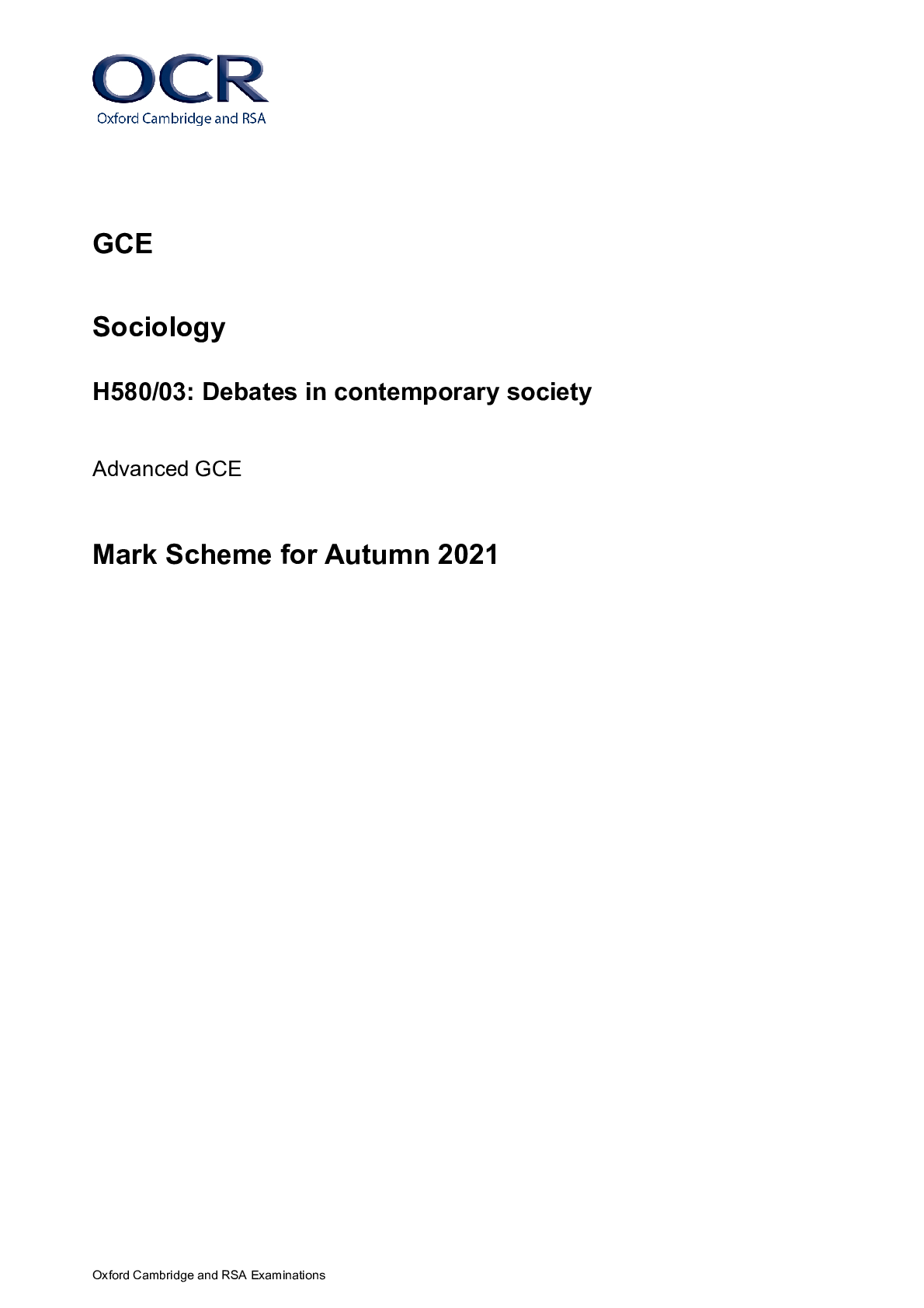
Buy this document to get the full access instantly
Instant Download Access after purchase
Add to cartInstant download
Reviews( 0 )
Document information
Connected school, study & course
About the document
Uploaded On
Oct 07, 2022
Number of pages
41
Written in
Additional information
This document has been written for:
Uploaded
Oct 07, 2022
Downloads
0
Views
63




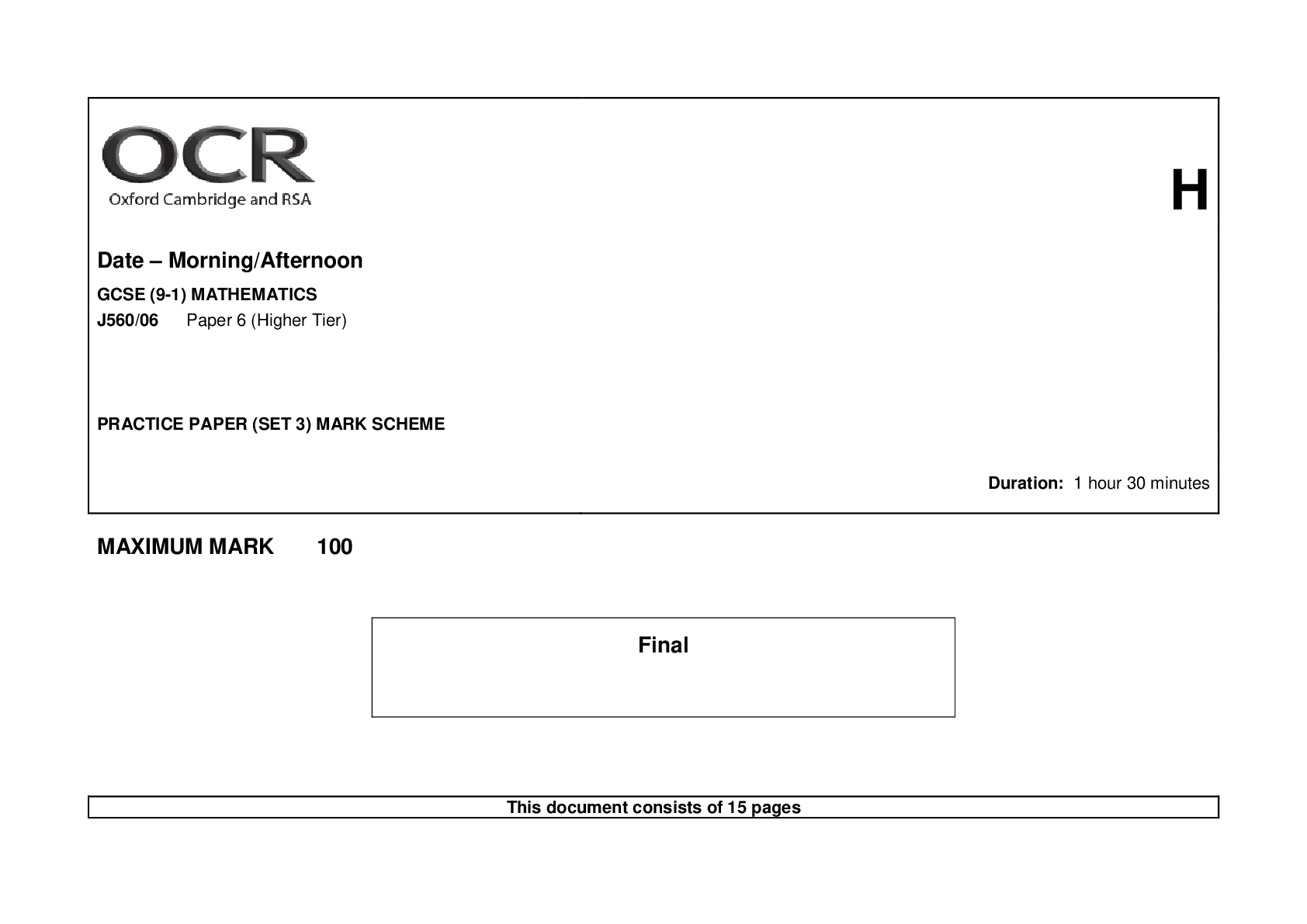

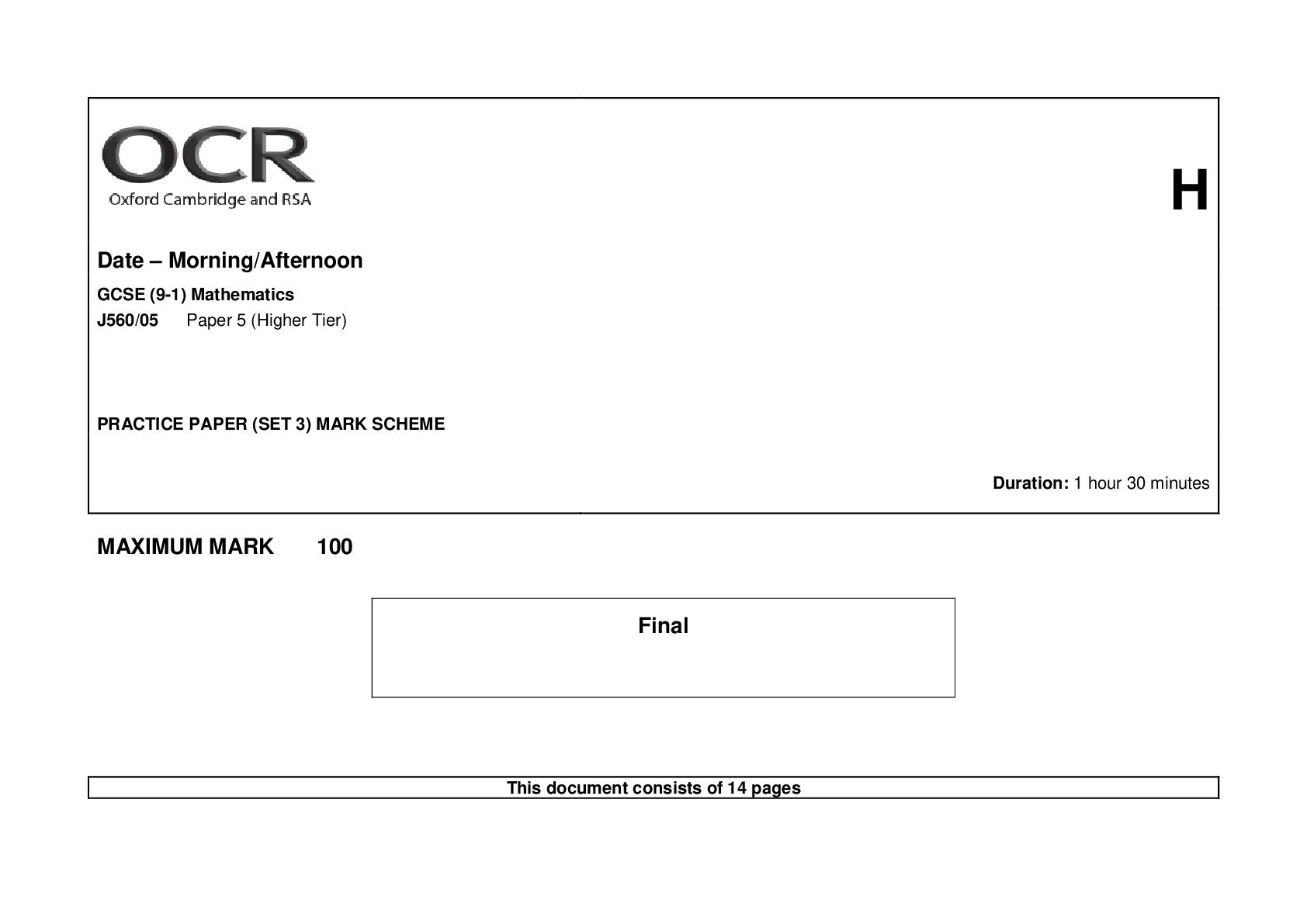





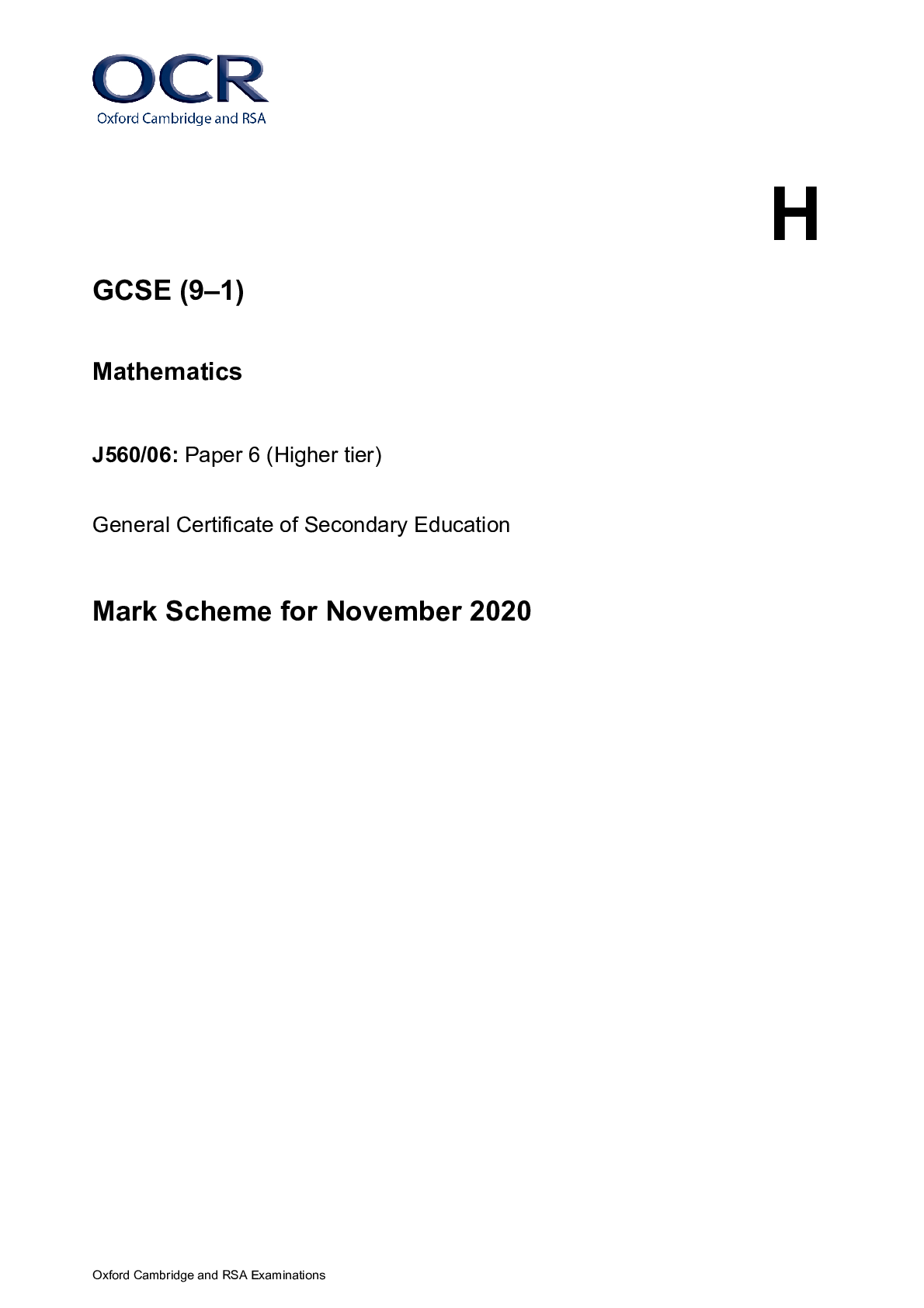
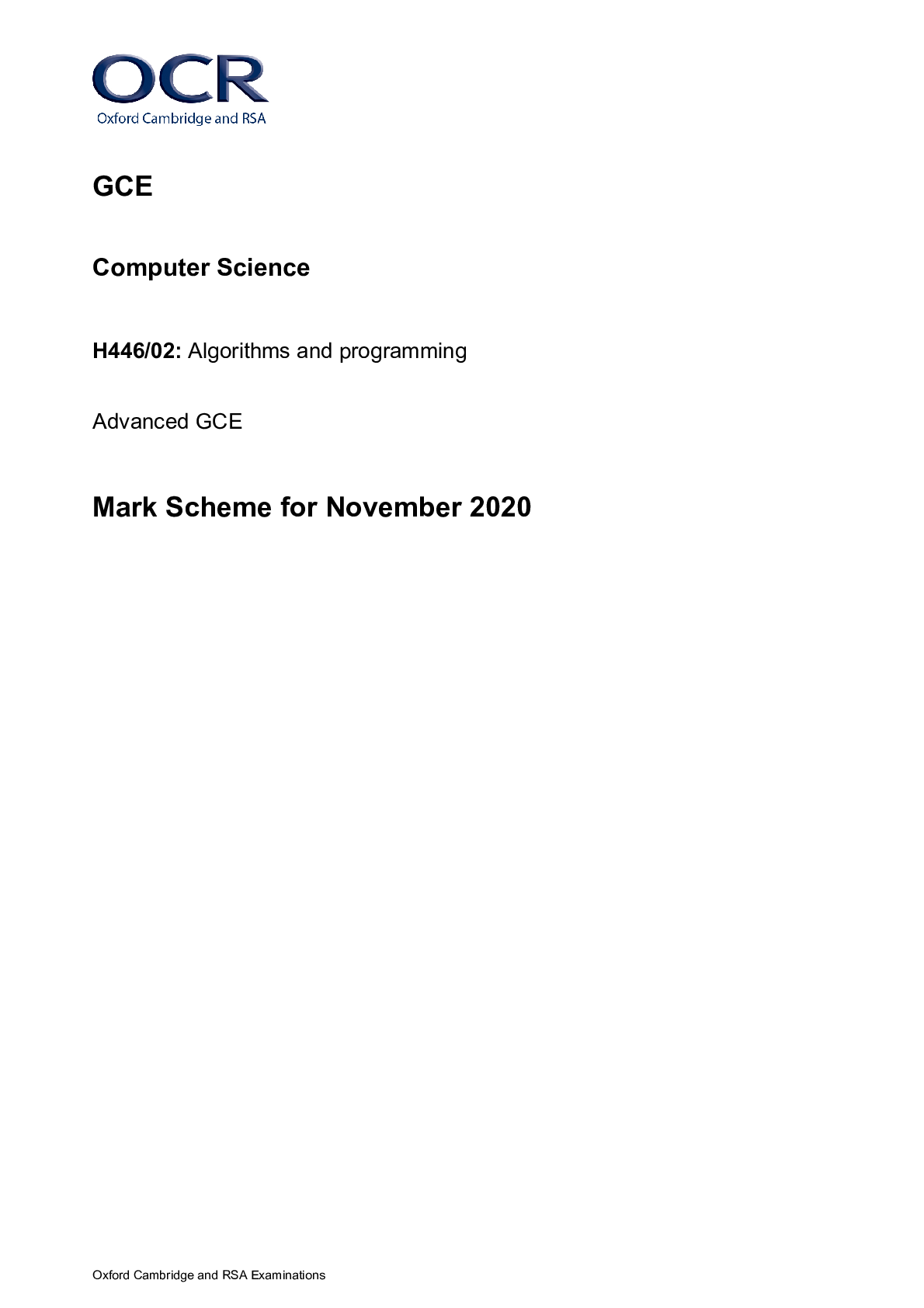
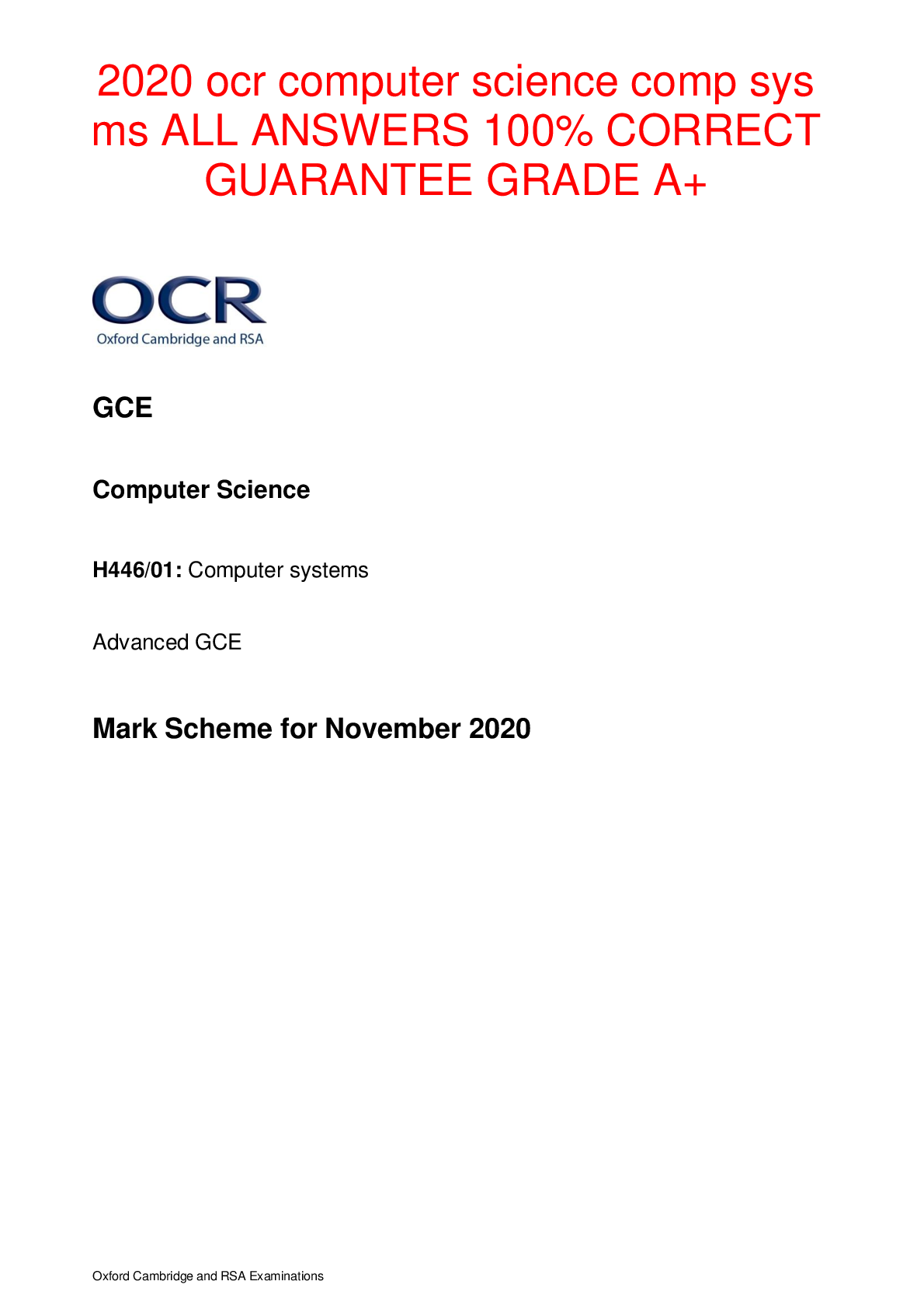
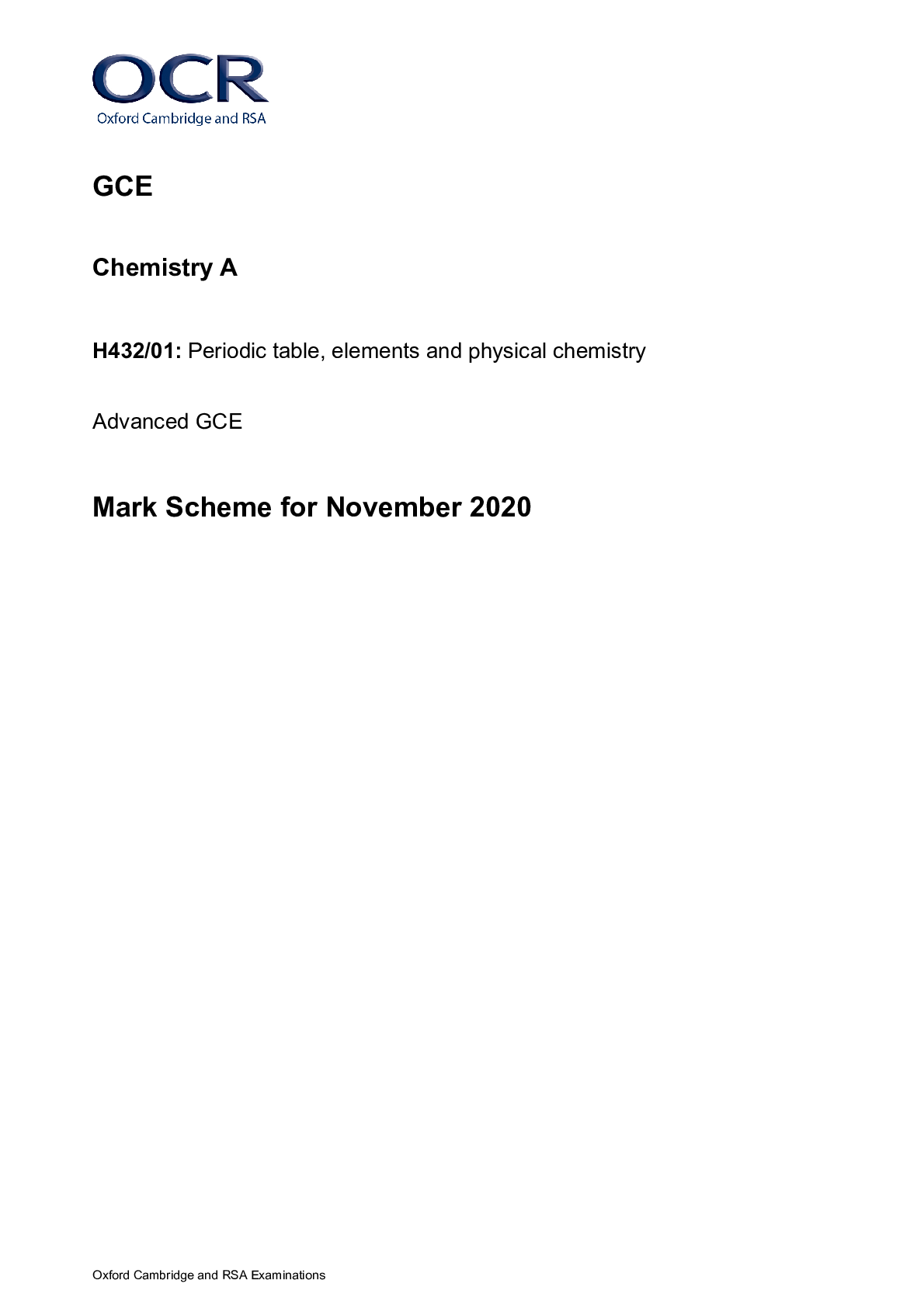
.png)

